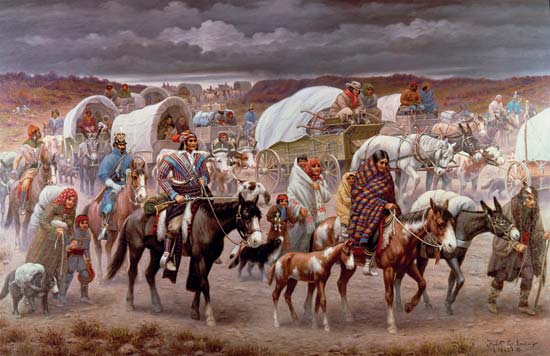Many Indians however
但是还有不少印第安人
wanted to pursue their tribal life,
希望追求部落生活
liberty and happiness
同时也想要自由和快乐
as inhabitants of the United States
就像那些祖祖辈辈一直居住在
right where their people had been living for centuries.
美国的印第安土著一样
The Constitution granted them that right, supposedly.
美国宪法算是给了他们这个权利

The so-called Indian question.
所谓的印第安人问题
The conflict over Indian removal started in 1802
印第安人被迫迁徙的冲突始于1802年
when the Georgia legislature gave up all claims
当时乔治亚州决定永久放弃
to territory west of Georgia for good.
它西边的所有领土
In return the United States government
作为回报,美国政府
pledged to eliminate all Indian titles
保证剥夺乔治亚州内
to land inside Georgia.
所有的印第安人的土地
The Georgians were particularly concerned
乔治亚洲人尤其针对
with the Cherokee people
切罗基族人
which occupied a large chunk of land
他们占据了乔治亚州内
inside the state of Georgia.
大片的土地
The Cherokee had adopted many western ways
切罗基族人已经采用了许多西方人的手段
including the enslavement of blacks
包括奴役黑人
and had settled into
而且也发展了南方的
the south's cotton planting economy.
棉花种植经济
In 1827 the Cherokee adopted a written Constitution
1827年,切罗基族人根据一项成文法
declaring themselves a sovereign nation
宣布他们是一个主权国家
with complete jurisdiction
对其领土及人民
over its territory and people.
拥有司法裁判权
Georgia did not recognize the Cherokee Constitution
乔治亚州不承认切罗基族人的宪法
seeing the Cherokees as
并且把他们看做
nothing more than illegal squatters.
违法占用土地的人
In 1827 the Supreme Court ruled against the Cherokee
1827年,最高法院决定支持乔治亚州
supporting Georgia's claim.
作出不利于切罗基族的裁决
The Cherokee returned to the Supreme Court in 1831.
切罗基于1831年重返最高法院
This time they got a decree
这一次他们得到了新的判决
granting them self-government
判决不仅承认他们的自治
and the decree also declared
还声明
Georgia's opposition was unconstitutional.
乔治亚的抗议是违宪的
However Georgia refused to abide by
但是乔治亚拒绝遵守
the Supreme Court decree.
最高法院的判决
President Andrew Jackson, Old Hickory,
安德鲁·杰克森总统
was an old Indian fighter himself
是一名印第安老战士
and he refused to enforce
他也拒绝实施
the Supreme Court's decree also.
最高法院的裁决
In practice the Constitution's pattern of
实际上,宪法的
checks and balances did not apply
分权与制衡功能
when it came to American Indians.
在印第安人问题上并没有起作用
The Jackson administration's answer
杰克森政府对印第安问题
to the Indian question was the Indian Removal Act
的回应就是印第安人迁移法
signed by President Andrew Jackson in 1830.
于1830年由安德鲁·杰克森总统签署
This act enabled the president to quote/unquote
此法让总统能够
"negotiate removal treaties with all Indian tribes
"与密西西比河以东的印第安部落
east of the Mississippi River."
协商迁移的条约"
The Indians would trade their lands
印第安人会用
east of the Mississippi
密西西比河以东的土地
in exchange for lands west of the Mississippi.
用来交换密西西比河以西的土地
Those Indians who wished to stay
那些希望留在
where their ancestors had lived for centuries
祖先生活的地方的印第安人
would have to fall under the laws of that state
就必须服从所在区域
which claimed their territory.
州政府的律法和管理
Jackson claimed that the Indian Removal Act
杰克森声称,印第安人迁移法
would protect the Indians
能保护印第安人
and allow them to quote/unquote
并让他们能够
"become civilized by adopting western ways."
"通过学习西方的方式成为文明人"
Eventually almost all of the Native Americans
最终,大部分的印第安土著
were forced to move west.
都被迫西迁
Ethnic Cleansing, American style.
美国式的种族清洗
The most famous of these Indian removals
最臭名昭著的一次印第安人迁徙
became known as the Trail of Tears
被称为"血泪之路"
in which 12,000 Cherokee were forced to
12000名切罗基族人被迫
trek over 800 miles to their new lands.
跋涉超过800英里到新的居留地
Along the way over 4,000 died of famine and disease.
途中超过4000人死于饥饿和或疾病












